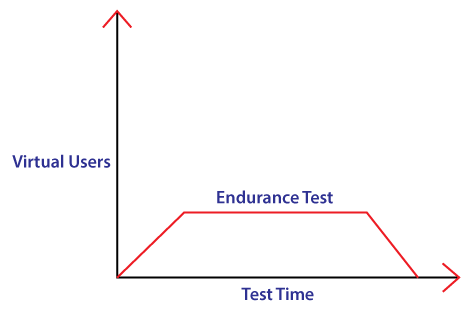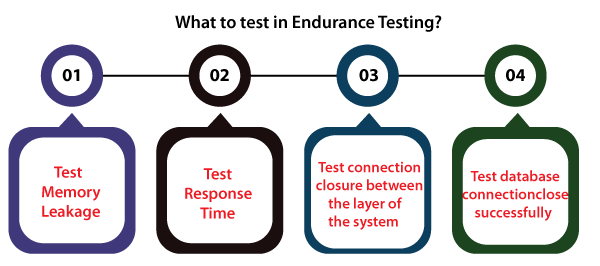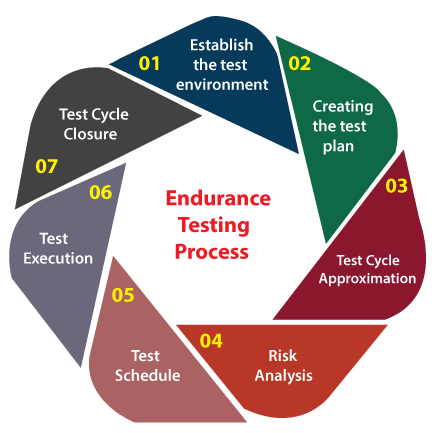Endurance TestingIn this section, we are going to explore the following topics related to the particular testing technique known as endurance testing in detail.
What is Endurance Testing?In Software testing, we have several different types of testing that are very effective while analysis any software or application. Here, we are discussing another type of software testing, which is known as Endurance testing. Endurance testing is testing where we test the system performance under certain load conditions over an extensive period. Endurance testing is one of the significant parts of non-functional testing. Generally, it is also known as Soak testing and longevity testing. Endurance testing is done at the last phase of the performance run cycle. Note: Soak testing is used to test the behavior of an application in the environment, which is unsupportive for a long time. Usually, soak testing is a destructive type of testing; subsequently, we already know that the server or domain is not supportive.In order to evaluate the response of a tested component under possible replicated situations for a specific load and time, we used to implement the endurance testing. 
In simple words, we can say that the term Endurance is used to define the capacity of something to last, which is further call it as durability, ability, or Endurance. The memory consumption is measured to fix potential failures and determine the performance quality throughout Endurance Testing. For enhancing the consistent parameters of the software application, we can record the performances in the endurance testing. To find out any memory leaks in the system, endurance testing is beneficial, and it also helps us test the response time of the system over a more extended period. During the endurance testing, the testing is performed for a more extended period as per the given testing requirements, such as 15 hours, 90 hours, as compared to other type of testing such as load or stress testing. And that makes endurance testing vary from Load Testing, which generally ends in a couple of hours. The Objective of Endurance testing
What to test in Endurance Testing?During the execution of endurance testing, we will test the following aspects:

Test Memory LeakageIn the implementation of endurance testing, checks are done to verify any memory leakage in the particular software or an application, which can cause failure of the system or operating system. Test Response TimeWe can also examine the test response time. And the application or system is tested for the response time of the system as the application becomes less operative as an output of the system's using endlessly. Test connection closure between the layer of the systemDuring the endurance testing implementation, if the connection between the system's layers is not closed effectively, it may stall some or each modules of the system. Test database connection close successfullyIf the database connection is not closed successfully during the execution of endurance testing, we may get output in a manner of system crash. Example of Endurance testingLet us see an example of Endurance testing for our better understanding of the particular topic. Here, we will see the example of the memory leak concept, but we will first understand what memory leak is? Memory Leak: It is the most commonly faced issue in computer science. It is a breakdown to release objects that are no longer used because of a vulnerable programming code written by a developer. In endurance testing, the test engineer will execute the system for a fixed amount of time by providing a specific quantity of load to test any memory leak. Handling memory leak issues are completely varied in the usage of programming language. Hence, we will see one real-life example of any bank. Example:
Endurance Testing ProcessThe process of endurance testing is completed into the following steps:

Let's discuss them one by one for our better understanding: Step1: Establish the test environmentThe first step of the endurance testing process is creating or establish the test environment. This step will find the necessity of software, hardware, operating system, and database to execute the endurance test. The test environment should be prepared before the test execution, and it should be separated appropriately from the actual live system. The creation of team is included to execute the endurance testing and handover the roles and responsibilities within the group. Step2: Creation of Test Plan and Test ScenariosAfter completing the first step of the endurance testing process, we will move to the next step, creating a test plan and test scenarios. In this, the test cases should be designed, reviewed, and execution should be prepared based on the necessity of manual and automation testing or a combination of both. The application's breakpoint should be decided, and it should be confirmed how much load would be put on the application throughout an Endurance test. Step3: Test Cycle ApproximationAfter the completing both step1 and step2, we will move to the next step of endurance testing, Test Cycle Approximation. The time of every test phase and how many test cycles are required are evaluated in the test cycle approximation step. It provides an approximation of how much time is required to complete the testing phase. It should be evaluated based on the number of test engineer included and the necessity of number of test cycles. Step4: Risk AnalysisThe risk analysis is the most critical step in the endurance testing process. Here, we will prioritize the test cases based on the risk factor. And below are some of the most commonly faced issues and risks by the test engineers during the endurance test.
Step5: Test ScheduleIn the next step of the endurance process, we will conclude the budget, deliverables, and timeframes for the further process. Step6: Test ExecutionOnce the test schedule has been set, we will move to the next step that is test execution. In this, test cases are implemented as soon as the environment is ready, and if there are any issues recognized throughout this stage, they are also noted down. And the developers will solved these issues and retesting is performed after they are fixed. Step7: Test Cycle ClosureThe last step of endurance testing is test cycle closure. As soon as the test cycle meets the testing process's exit criteria, it will be considered closed, and a report of recognized issues and their final status will be arranged. Advantages of Endurance TestingSome of the significant benefits of endurance testing are as discussed below:
Drawbacks of Endurance TestingThough the execution of endurance testing is helpful for an enhancement of an application, there are still some drawbacks of endurance testing, which are discussed below:
OverviewIn the above article on endurance testing, we have discussed the in-details process of endurance testing, an example of endurance testing, some essential benefits and drawbacks of performing the endurance testing. Finally, we can say that Endurance Testing is non-functional testing and a subcategory of load testing using performance testing. Endurance testing is performed to check the performance of the system under constant use. In terms of detecting the issues such as memory leaks, the execution of endurance testing is essential. These issues can be the reason for system failure, causing the loss of crucial data. Endurance testing is making the application more robust and prepares it to sustain under continuous heavy loads. We should prevent performing endurance tests manually, as it is a very time-consuming process. That's why it is mainly automated. Some of the most frequent tools used for Endurance test are Apache JMeter, LoadUI, LoadRunner, WebLoad, IBM Rational Performance Tester, etc. The time of the Endurance test depends upon the business, project, and client requirements. It may last for 10-15 hours or few days or a month or sometimes even a year. The endurance test process begins with establishing an isolated test environment, creating test plans, estimating test cycle duration, analyzing the risk, preparing the test schedule, executing the endurance test, and finally closing the test cycle.
Next TopicReliability Testing
|
 For Videos Join Our Youtube Channel: Join Now
For Videos Join Our Youtube Channel: Join Now
Feedback
- Send your Feedback to [email protected]
Help Others, Please Share









